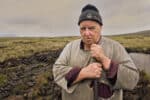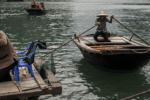From the same light shaper. When Gary Astill, the peerless designer at Lastolite and I were brainstorming, I mentioned the quality of light translating through a Lastolite Skylite panel was always quite nice, but it was occasionally too much light. The source, a diffuser panel, is basically a 40′ square. It would often envelope the subject, sometimes in lovely fashion, but other times, it could have a tendency to swamp the subject, flooding them with too much light. I have an active imagination and I had visions of the subject drowning in light, gurgling something like “Use a more narrow source,” as they bubbled downwards in a sea of photons.
Below is an example of the the skylite, used frontally, with a bit of bounce fill card action from below. This type of an approach gives you a full look, very soft, flattering and open.
That discussion about volume of light with Gary prompted the Skylite Rapid Diffuser w/ Masks. You still have access to a large square of light, but you can patchwork quilt it down to a very narrow, still soft, beam. It’s handy.
I demonstrated this to an advanced lighting class in Dubai recently. Jon was our test subject to start, and he was bracketed between two open Skylites, filled with light. The result is predictably soft, and very diffuse. There is detail throughout his face, and hair, and the fall to shadows is very gradual.
But then, to demo the process of doing an in camera double exposure, I needed much more narrow light. Reason being, of course, to do a double, you really need control and you need areas of the subject’s face and environment to go really, really dark. You need a definitive line of demarcation between highlight and shadow, a very distinct border. And the fall to shadows has to be quite quick and complete.
Bring out the masks! They velcro to the source and turn a 40″ square of light into a strip light soft box, essentially. Handy and quick. You can also see below, there is gaffer tape masks shrouding my speed lights, which are affixed to a Tri-flash. I didn’t need lots of power for this particular setup, but we were heading into the realm of high speed sync that day with the class, so we simply got multiple speed lights ready early on. But the gaffer tape helped control the spill and splash of light on the set. When doing in camera moves such as multiples, it speaks to exerting all the control you can over the nature and spread of the light.
On that day we worked with big flash and small flash, showing how to use TTL groups to shoot double exposures, and then we did a big flash double, with a focus shift. The in camera controls, programming the numbers of exposures, and the camera factoring the potential exposure gain take a lot of the guesswork out of multiples.
Below is an overall of the setup.
I demonstrated this for a few frames, using the multiple exposure mode in the camera set to two exposures, and using my focus cursors to help me map out her position. Quick result, and informative for the class.
We continued into the realm of bigger flash, and did one of these with this dancer and two Profoto B1 lights, with the upfront source being a 1×3 RFI strip, and the larger source in the second, or background exposure, being two 1×6 RFI strip lights. Made the first exposure, shifted her position, and the focus, and she struck a dancer’s pose for the second.
In a blacked out studio, you have control, which is what you need. We did not have that for these demos, but close enough, and the class had fun observing the process. As did Cali and Jon, who decided to enact their own pas de deux for the camera. The great thing about having them as first assistants in the studio is that they are also very good friends. So they decided to do a quick “bromance” spoof for the class. Camera and lens setup across the board here was the Nikon D4S fitted with a 70-200mm f2.8.
Fun with lights, camera, action! Good friend and fellow shooter, Jeff Snyder, has seen these sources in action, having been with me on set numerous times, and can always check in with him as to ease of use, availability, etc. jsnyder@adorama.com.
More tk…




















Love it Joe. You are always a frontrunner in photography!
Joe, thanks for sharing this. I feel that stills photographers, you excepted, feel that the soft box and umbrella are the goto light modifier. If they only knew! A simple scrim frame, in this case the Lastolite Skylite Rapid offers so many more options as it allows the light and modifier to move independently creating more looks than just a fixed modifier. The masks are genius and save messing with Black Wrap etc:)
Loving the double exposures!
Dav